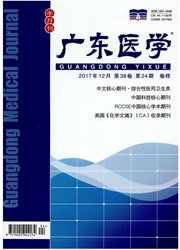

 中文摘要:
中文摘要:
目的比较经食管心脏电生理检查术与其他各无创鉴别方法诊断宽QRS波心动过速(WCT)的优劣。方法入选接受经食管心脏电生理检查并诱发心动过速成功,最后行心内电生理检查确诊的161例患者,平均年龄(36.43±14.24)岁。分析心动过速时体表心电图,采用Brugada四步法以及经食管心脏电生理检查对WCT进行鉴别诊断。所有患者均行心内电生理检查明确诊断,并对以上鉴别WCT方法的敏感性、特异性、阳性预测值、阴性预测值进行统计。结果 161例WCT患者中心内电生理检查诊断提示有94例为室性心动过速(VT),Brugada四步法有74例(准确率78.7%),经食管心脏电生理检查92例(准确率97.9%)。经食管心脏电生理检查比Brugada四步法对鉴别WCT的VT有着更高的敏感性(P〈0.01)和阴性预测值(P〈0.01)。而且经食管调搏终止心动过速成功率在室上性心动过速患者远高于VT患者(P〈0.01)。结论在无创鉴别诊断WCT的方面,经食管心脏电生理检查显著优于Brugada四步法。
 英文摘要:
英文摘要:
Objective To compare the differential diagnostic value of esophagus cardiac electrophysiological examination technique and other noninvasive identification methods in wide QRS complex tachycardia( WCT). Methods The study sequentially enrolled patients who accepted esophagus cardiac electrophysiological examination and with successfully induced tachycardia prior to invasive electrophysiological assessment. Twelve- lead electrocardiogram of tachycardia were record and analyzed by Brugada's four- step approach and esophagus cardiac electrophysiological examination for differential diagnosis. The sensitivity,specificity,positive predictive value and negative predictive value of above- mentioned approaches were calculated. Results A total of 161 patients with WCT were selected,with mean age of( 36. 43 ±14. 24) years. The invasive electrophysiological study identified 94 patients as ventricular tachycardia( VT). Brugada' s four- step approach identified 74 patients( 78. 7%) and esophagus cardiac electrophysiological examination identified 92patients( 97. 9%). Esophagus cardiac electrophysiological examination had a higher sensitivity( P〈0. 01) and negative predictive value( P〈0. 01) than Brugada' s four- step approach for VT. Furthermore,supraventricular tachycardia was more easy to be suppressed than VT via esophageal burst stimulation( P〈0. 01). Conclusion In the noninvasive differential diagnosis of WCT,esophagus cardiac electrophysiological examination is significantly more useful than Brugada' s four- step approach.
 同期刊论文项目
同期刊论文项目
 同项目期刊论文
同项目期刊论文
 期刊信息
期刊信息
